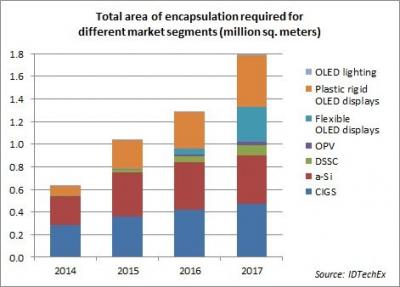IDTechEx estimates that the barrier (encapsulation) layers for flexible electronics market will reach over $200 million by 2024. This will be driven mostly by flexible OLED displays for phones, tablets and wearables. Following is details regarding the different technologies adopted by Samsung, LG and others.

Samsung is using Vitex's multilayer thin-film encapsulation (TFE) using three layers (this is a new achievement, up until now they had to use at least 6 layers). While Samsung will still use this technology for its current and next-gen displays, Samsung is also considering other encapsulation deposition technologies, including Veeco's FAST-ALD and Universal Display's UniversalBarrier.
LG Display has adopted a hybrid solution based on TFE - ML encapsulation inorganic/organic/inorganic plus a face-encapsulated barrier (probably deposited by PE-CVD). LGD calls their technology Face Seal.
Several other OLED makers (AUO and BOE, for example) also adopt a similar hybrid scheme. The present focus of those companies is to start glass-based display mass production, and flexible displays are at the R&D stage.
IDTechEx further says that in-line deposition has the potential to offer the best barrier performance and flexibility. But directly depositing inorganic layers on OLED devices requires the deposition technology to be compatible with the bare device.
Encapsulation by lamination of engineered foil is more expensive (due to the cost of base-film, adhesives, and desiccants which are in-development or low-volume production), and the bonding process is relatively slow. Other encapsulation options include flexible glass and ALD.

